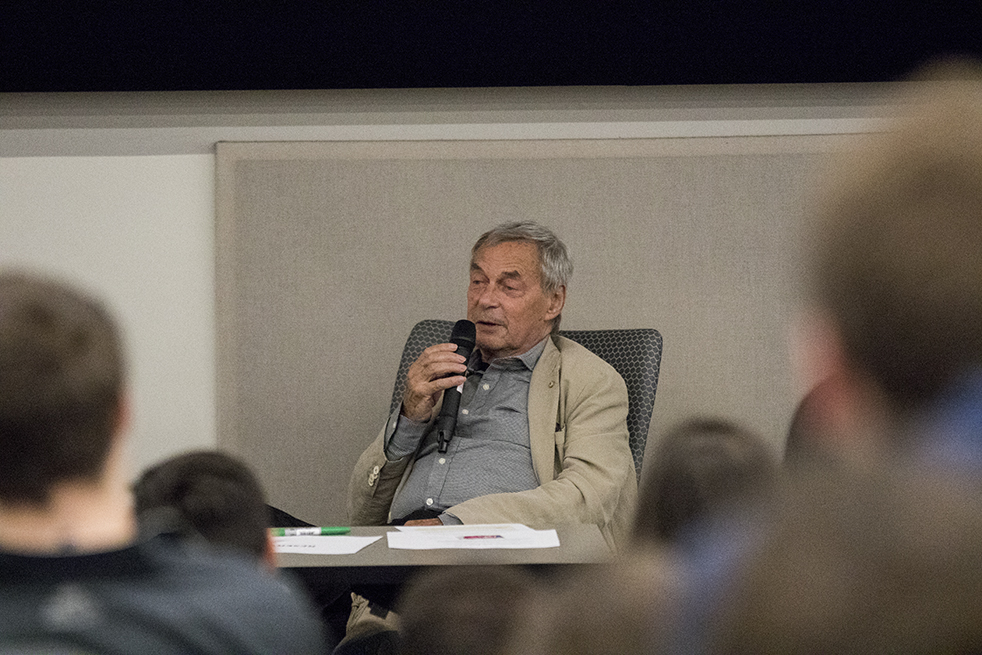
Ernő Rubik garnered quite the crowd this week upon his arrival at Tech for his special talk. Wednesday, April 11, Rubik visited Tech to give a lecture on a variety of topics, including design and architecture, the role of curiosity in the human condition and his perspective on more than four decades of the Rubik’s Cube. Ernő Rubik is an architect and designer. He lives in Budapest, Hungary, where he invented Rubik’s Cube in 1974.
In a talk sponsored by the College of Science, the School of Mathematics and the Gathering 4 Gardner Foundation, Rubik discussed his process of creating the cube and gave advice to the audience on how to cultivate their own future. The program started with a demonstration of talent. Jeff Varasano, who currently runs a pizzeria on Peachtree and was the first world record holder of fastest “cuber,” demonstrated his ability to solve the cube quickly.
Next, a group of three super-speed cubers, Chris Hardwick, Lucas Garen and Sydney Weaver, raced against each other. The winner of the first race finished solving a Rubik’s Cube in under fifteen seconds. Each of the participants explained how they have been practicing. They suggested memorizing algorithms, practicing daily and most importantly, having fun with the process. The second time they raced, the participants only used one hand, and all finished within twenty-five seconds.
Then, the real event began. The moderator of the talk began asking Professor Rubik about his invention and inspiration.
“Let me begin by asking him a question I’m sure he’s never heard before,” the moderator sad, “What gave you the idea [to create the Rubik’s Cube]?”
“A lot of people here are younger than the cube… at this age… memory is tricky.” He remembered the most exciting days and forgot the mundane ones, but he vividly remembered the time in his life where he was thinking of this invention. It was a bright time when he was finishing school. He loved university, and as an architecture student he was supposed to focus on buildings. However, he was more interested in working with the small details of his creations rather than the broad focus of architecture and construction.
Some of his major interests were geometry, understanding three-dimensional spaces and art. Art wasn’t his particular area of expertise and he wanted to do something more practical and useful that fulfilled the needs of people. He wanted to make something, not something just for people to see, but to interact with, to be as inclusive for as many people as possible “and to teach!”
Rubik set out to create an object that contained many faces and elements that were capable of changing positions in relation to each other. At the same time, he wanted all the parts to be cohesive and ordered.
When Rubik stated that “it all started behind the Iron Wall,” the audience whispered in hushed tones, realizing how long this puzzle has been in circulation and influencing young minds.
The moderator continued by asking, “Did [it] surprise you how mathematicians jumped on the cube and made so many discoveries because of it?” Rubik confessed that he has loved math since the beginning of his schooling, in fact, it’s hard for him to understand how other people don’t like math as much as he does. “Life is very mixed and it is difficult to know what the right direction is [or] what is true… If you are searching for a clear picture,” he said, “math [has] it.”
What was clear to the audience through the questioning was that people like Rubik bring us spaces. Rubik himself has given us a recreational space that lies on the intersection of mathematics, talent and creativity.
He found a way to drop some very wise life advice while he was giving his lecture.
“Life is too short…” he said. The professor explained that an individual must find shortcuts and tricks if they want to solve problems rather than being tempted into thinking about every individual outcome. In the final minutes of the talk, Rubik was asked what advice he would give to young people who want to incite positive change in STEM and STEAM (STEM with the addition of “Arts”).
“We have to know what we are capable of, what we enjoy.” Rubik looked out into the crowd with a smile. “The task for the school,” in his opinion, “is to show students the possibilities.” Rubik says to try everything, do everything and try as many options as possible. If you find something you love and have a passion for, “keep it, and don’t give it up.”
Ernő Rubik will also present on “Cubic Tales” at the G4G13 conference in Decatur this weekend.
